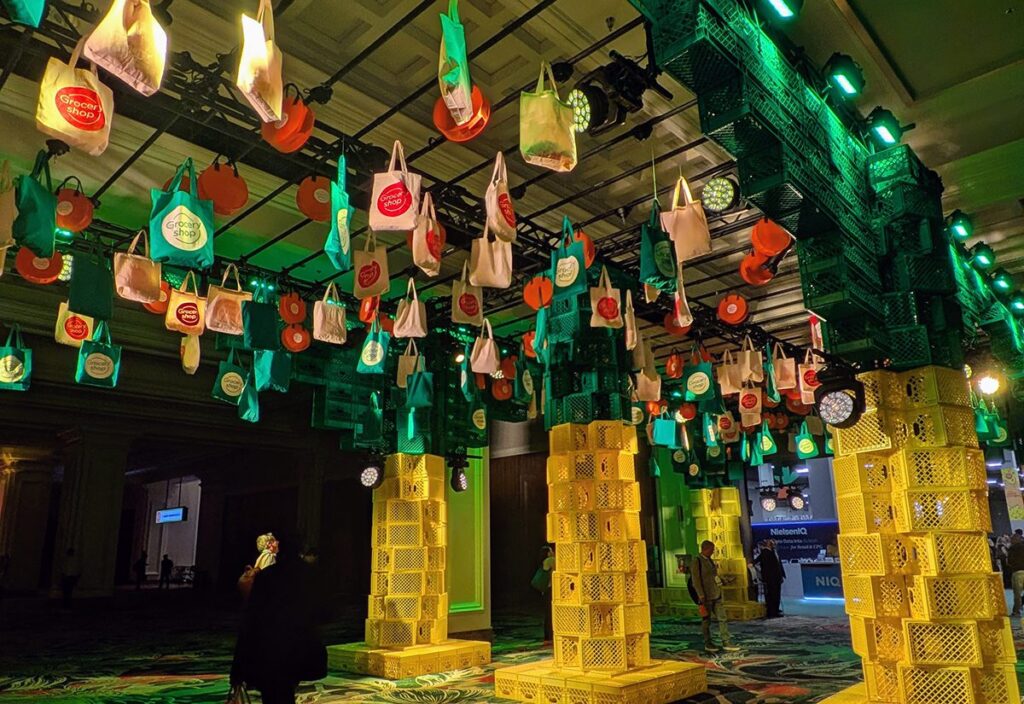
First, The Bad News: Spending On Event Marketing Fell in 2006.
The average spent per company dropped to $685,598 from $795,147 in 2005, according to PROMO’s 2007 Event Marketing Trends survey.
If there’s any good news, it’s that many firms plan to increase their event budgets this year. And they are now better able to measure results.
What Caused the Downturn?
“People were kind of throwing money at the space thinking it would solve a lot of problems,” says Charlie Jones, chief marketing officer of RedPeg Marketing, Alexandria, VA. “Then, there was a bit of pause.”
Many firms pulled back because the ROI didn’t match their goals, Jones says. Others took a break to sharpen their event-planning skills.
“Lots of people said: ‘We have to get in the game,’” Jones continues. “Unfortunately, they didn’t sort out their best practices, and they may not have gotten the kinds of results they wanted.”
Despite the falloff, 37.8% plan to boost their event budgets this year. In contrast, 8.5% will decrease spending and 53.7% said their numbers will remain the same. But it remains to be seen if the average per firm will hold.
Either way, those that ramp up will do so because they are seeing results, according to Jones.
Take Mutual of Omaha. It drew more than 600,000 people to its Wild Kingdom Adventure Tour last year, using game cards to collect data on 150,000 attendees. And these names are already producing: 6% requested a phone call from an insurance agent.
“That’s phenomenal,” says John Hildenbiddle, senior vice president brand management and public relations for Mutual of Omaha. “If you get 1%, you think you are doing awesome. We wanted the sales people to know these were solid leads.”
Mutual of Omaha is typical in at least one way: Half of the firms surveyed capture personal data at events.
Meanwhile, brands are getting better at determining ROI and acting on the results.
Just What Are They Measuring? Everything Imaginable.
For example, 45.7% tracked sales data last year. And the same number measured purchase intent. Usage of both metrics rose by roughly 8% last year.
Sales volume is also helpful in gauging if customers are happy. Two thirds tracked it last year, compared with slightly more than half in 2005. “Sales volume justifies the continued investment in what they are doing,” Jones says.
Another useful metric is altered brand preference, as measured in polls or exit surveys. “It’s the ‘ah, ha’ moment for a lot of consumers,” Jones explains. This was studied by 29.3%, a slight increase over 2005. And 43.6% tracked Internet hits last year (up from 34.7% in 2005).
“People are starting to figure out it’s not as hard to measure marketing,” says David Rich, vice president of strategic marketing worldwide for The George P. Johnson Co., North Easton, MA. “ROI is the most sophisticated of the measurement tools.”
And one thing seems certain: Event marketing works spectacularly when done right.
“Often, the event is the most direct way to engage people,” says Stuart Ruderfer, co-CEO of Civic Entertainment Group, New York.
Live promotions come in different forms. Of the marketers surveyed, 48.4% sponsored events run by other firms. Another 44.1% hosted their own, and shouldered most of the cost.
Also important is venue. Retail events were the most popular, perhaps because of the nearby cash registers. They were followed by entertainment, sports and musical events, and then by community get-togethers, health fairs and campus activities.
On the entertainment front, Cinemax drew 200,000 people to an event plugging a Star Wars movie marathon. Visitors took part in light saber fights against professional fencers, and posed for photos with movie characters. Roughly 10,500 attendees walked home with a branded saber key chain or a framed photo.
And it paid off. Cinemax reported its highest-rated weekend since 2004, with each film averaging 3 million viewers. Civic Entertainment Group handled the event.
“With entertainment and sports, you have a built-in passionate audience,” Ruderfer says. “And if you reach out to that audience, then they will become the evangelists.”
And What are the Firms Doing in the Field?
The biggest single activity is sampling. Almost 60% sampled at events last year compared with 52.6% in 2005.
“Sampling is one of few tactics that gets the product in the hands of the consumer,” says Jay Lenstrom, CEO, The Radiate Group, Chicago. “It’s measurable, it involves trial and you get immediate feedback.”
Case in point: Kraft Food’s Tassimo. That brand handed out more than 22,000 coffees, lattés, teas and hot chocolates in New York’s Bryant Park to drive holiday sales of its hot beverage system.
“We always say tasting is believing,” says Lori Acker, director of marketing for Tassimo.
In addition, Tassimo lured people to the park for a re-gift exchange event. The hook? Bring in an unwanted gift and swap it for a beverage-making machine worth $170. In addition, the company donated gifts to a local charity.
It worked. Tassimo dispensed 200 machines on Nov. 30 as part of the $225,000 campaign. Newspaper ads and 60-second radios spots supported the effort.
“Our job is to grab your attention,” adds Cathy Lang, chief marketing officer at Aspen Marketing Services, which handled the event. “We know we have to bribe you.”
How Are Marketers Driving People to Marketers?
E-mail is the most popular medium. Almost two thirds rated it as “important to extremely important” for its low cost and viral capabilities.
No. 2 last year was word-of-mouth, followed by direct mail and in-store promotions.
Meanwhile, even the best event marketers face challenges.
For starters, Mother Nature can wreck almost any event. But most of the issues have to do with personnel.
It takes people to run events. But where do you find them?
Last year, 45.2% of the respondents hired employees via an agency, compared to 33.2% in 2005. Another 43.1% used an internal database of candidates, a slight drop from 2005.
But no hiring process is foolproof.
“You can end up with someone with green spiky hair and tattoos and piercings all over everything,” Lang says. “To manage that base of local talent is cumbersome and difficult.” As a result, companies are spending more time training event staff.
More than 30% of the firms surveyed outsourced training to agencies in 2006, compared with 26.3% in 2005. At the same time, 29.8% said that training was conducted both internally and by outside agencies, compared with 23.2% in 2005.
“[Ambassadors] are viewed as employees of the brand,” says Lenstrom of The Radiate Group. “It’s critically important to spend the days, hours and time necessary to train people. They provide an impression. It should be a positive one.”
Training is one thing. Field staff, on the other hand, should understand the essence of the brand they are representing.
“It’s not just about having pretty people,” Jones adds. “You’ve got to have people who can honestly represent the brand.”
Here’s one more prediction: Look for agencies to get involved earlier in the planning process.
“Three or four years ago, we were the last people called in,” Lenstrom says. “Now, we are at the strategy table with the chief marketing officer. What’s happening is people are realizing the power of event marketing.”
Methodology
This survey was conducted for PROMO by Prism Business Media Marketing Research, an in-house firm. It was e-mailed to 8,455 PROMO subscribers. Participants were chosen on an nth name basis (a representative sample of all subscribers).
An initial copy of the survey offering a chance to win one of four $50 Amazon.com gift certificates was sent out Nov. 8. A follow-up e-mail was sent to non-respondents.
The base list included readers from corporate brand, agency and retail companies. Results are based on surveys returned by 188 qualified participants.
Event Budgets
| 2006 (Projected) | 2007 | |
|---|---|---|
| Increased | 38.8% | 37.8% |
| Decreased | 12.8% | 8.5% |
| Stayed the Same | 48.4% | 53.7% |
Spending Levels
| 2004 Average-$901,935 | 2005 Average-$795,147 | 2006 Average-$685,598 | |
|---|---|---|---|
| <$50k | 27.4% | 32.1% | 37.3% |
| $50K-$100K | 14.0% | 14.7% | 13.8% |
| $100K-$500K | 22.6% | 18.9% | 23.4% |
| $500K-$1 million | 12.8% | 8.9% | 10.1% |
| $1 million-$5 million | 11.0% | 8.4% | 8.0% |
| >$5 million | 6.7% | 6.3% | 5.3% |
| N/A | 5.5% | 10.5% | 2.1% |
Measuring ROI
| 2005 | 2006 | |
|---|---|---|
| Event headcount | 49.5% | 45.7% |
| Register sales data per event days | 37.9% | 45.7% |
| Future likelihood to purchase | 37.4% | 45.7% |
| Internet hits post-event | 34.7% | 43.6% |
| Samples, coupons distributed | 30.0% | 37.2% |
| Length of time engaged | 18.4% | 25.0% |
| Other | 4.7% | 5.9% |
Marketing Methods
| 2005 | 2006 | |
|---|---|---|
| Sampling | 52.6% | 59.0% |
| Sweepstakes | 50.0% | 53.2% |
| Coupons | N/A | 51.6% |
| Data Collection | N/A | 50.0% |
| Local Advertising | 43.7% | 45.2% |
| Radio Tie-In | 27.4% | 35.1% |
| Other | 7.9% | 2.7% |
Measuring The Consumer Experience
| 2005 | 2006 | |
|---|---|---|
| Sales Volume | 54.2% | 66.0% |
| Expressed purchase intent | 41.1% | 39.9% |
| Brand preference altered | 27.9% | 29.3% |
| Other (Brand awareness, loyalty, email hits, etc.) | 7.9% | 7.4% |
| N/A | 18.4% | 3.7% |
Who Trains The Staff
| 2005 | 2006 | |
|---|---|---|
| Agency staff | 26.3% | 30.9% |
| Brand staff | 23.7% | 29.8% |
| Agency and brand staff | 23.2% | 29.8% |
| No training provided | 12.6% | 14.4% |
| Electronic training (CD or internet) | 12.1% | 10.1% |
| Other | 3.7% | 6.4% |
Top Event Types
| 2006 | |
|---|---|
| Retail | 34.0% |
| Entertainment | 21.3% |
| Other | 17.6% |
| Sports | 14.4% |
| Music | 11.2% |
| No Answer | 1.6% |



